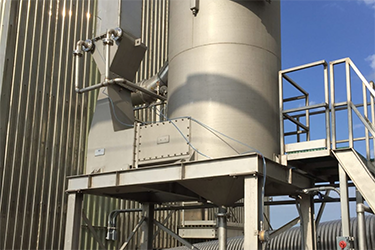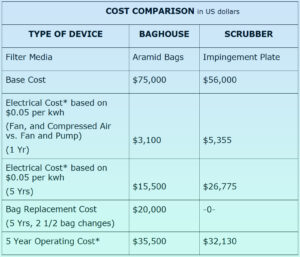
Dust collection equipment: Pros, cons, and alternatives you may not have thought about
Mike Edwards
Features baghouse dust collection Sly wet scrubbers
Keeping an open mind when selecting a dust collector can yield significant benefits. Here’s a quick review of available technologies to investigate to make sure you haven’t overlooked an opportunity.
By Bill Kurz
Even knowledgeable, experienced operators of dust collection equipment sometimes get “tunnel vision” when it comes to selecting a new piece of equipment. They may be overly influenced by past personal experience or convinced by a salesperson pushing one technology over another. In either case, changing dust collection equipment designs and evolving media technologies make it imperative to avoid automatically assuming any one method of collection is “best”. It pays to review all of your options.
Pleated Bag vs. Cartridge
Here’s an example. An experienced engineer, whose powdered metal production facility has operated numerous dust collectors for dozens of years, wanted new collection equipment located indoors to save energy by returning cleaned air to the plant. He specified traditional baghouse technology — tubular fabric bags with wire cages — because the plant had successfully employed them earlier. The dust collection equipment manufacturer pointed out that the low ceiling in the plant would not accommodate a baghouse…it would be too tall to fit. The equipment maker suggested a pleated bag collector as a good alternative.
“No way,” responded the engineer. “We tried those collectors in the past and they didn’t work. Our fine dust plugged them, they had a very high differential pressure, and they were a mess to change out.”
After further investigation, it was discovered that the guilty “pleated bags” were not pleated bags at all. They were cartridges, which can look similar.
A pleated bag collector was installed indoors. It works very well, collecting the valuable dust as well as efficiently releasing it to be returned and recovered. An integral HEPA filter was included, allowing recirculation in the plant and energy savings.
The customer now happily operates three pleated bag dust collection systems. The lesson? A cartridge does not function like a pleated bag, even though it may look like one!
Points to Consider:
- Dust Release
- Space Available (Footprint and Height)
- Confined Space Considerations (Do you need to avoid entry into collector to change elements?)
- Dust Loading
- Design Pressure
- Explosion Venting Requirements
- Element Replacement Cost
- Element Washability
High Inlet Design vs. Hopper Inlet Design
Traditional baghouse wisdom often places the dirty air inlet in the hopper, the idea being that heavy dust particles will drop into the hopper without having to be collected first. Thus, when a metals producer went shopping for a collector for mill scale dust, it never considered an alternative, even though its previous collectors were experiencing wear problems from this highly abrasive dust on housings, hoppers and pleated filter bags. Bags were having to be replaced every six months, or less.
To reduce wear, a collector manufacturer suggested a unit with reduced internal velocities, wear cuffs on the bottom of the traditional felted bags and a high inlet classifying section to drop out heavier dust prior to the bag section. The new collector was designed at an air-to.cloth ratio of 4:1 versus 3:1 in previous collectors and an interstitial velocity of 222 fpm versus 520 fpm before.
The new collector has been running 2-1/2 years and has yet to require a bag change, while meeting all regulatory requirements.
Points to Consider:
- Inlet Loading
- Particle Size
- Bulk Density
- Abrasiveness of Dust
- Bridging Potential
- Space (Footprint and Height)
- Inlet Duct Layout
Wet Collector vs. Dry Collector
The potential use of a wet scrubber instead of a dry collector is a real “eye opener” for many people.
Before proceeding further, realize that wet scrubbers have limitations. They do not have as high a collection efficiency as dry collectors (baghouse or cartridge filters), and are much more sensitive to variations in air volume, temperature, particle size and inlet loading.
However, when emission regulations are not as strict, a water source is available, and the operator can readily deal with scrubber blowdown (water treatment), wet scrubbers can be very attractive when comparing total purchase and operating costs.
An example can be found at a processor of silica sand. A baghouse designed to handle the hot, moist, dust-laden air (300ºF, 7.4% water vapor by volume) from its rotary dryer would cost about $75,000 and require a 40 HP fan motor, a 1/2 HP rotary valve drive motor and consume 20 scfm of compressed air while operating.
A stack test indicated that inlet loading and particle size distribution would allow a wet scrubber to meet the EPA emission requirements. Additionally, both capital costs as well as operating costs were projected to be less for a scrubber than for a baghouse. An existing settling pond could provide water as well as accept scrubber discharge.

*Does not include maintenance costs for fans or rotary valves (baghouse), or pumps (scrubber). Also does not include any maintenance costs for pulse and solenoid valves for baghouse.
Points to Consider:
Air Stream
- Moisture
- Temperature
- Corrosiveness
- Dust Loading
- Particle Size
Efficiencies
- Regulatory Outlet Requirements
Utility Costs
- Electricity
- Water
- Compressed Air
Disposal / Recycle Costs
- Recoverable Product
- Water Treatment
- Wet Product or Dry Product
An emerging trend is the use of a scrubber to avoid the recently-mandated costs of NFPA-68 and NFPA-69 explosion protection regulations for combustible dusts. Under the new regulations, dry collectors require special filter bag construction, explosion vents or suppression, special rotary valves, and inlet duct isolation. This adds significant costs to the installation, and additional maintenance requirements, making scrubbers more attractive. This will be the subject of a future white paper.
Pleated vs. Traditional (Tubular Fabric) Bag
A specialty chemical company bought a size reduction mill and a product collector for a new project. Having had previous experience with pleated filter bag media, the engineer wrote a new specification that included pleated bags.
A dust collector manufacturer studied the situation in depth and provided two proposals: one for the requested pleated bag design and one for an alternative conventional tubular bag collector. Even though the initial cost of the conventional filter design was higher, the manufacturer convinced its customer to abandon thoughts of pleated bags.
Why? The chemical company was processing a product that was new to them. The dust collector manufacturer anticipated high material loading and potential release problems for pleated media. In addition, pleated filter life for the chemical was unknown, and the costs of modification to a pleated bag housing were expected to be very high if it didn’t meet expectations.
A collector with specially designed felted bags for release of sticky material was supplied, along with a two-year bag life guarantee. The collector has been in operation for nine years with only one bag change out.
To Get the Best Collector, Don’t Make Assumptions
The lesson of all four examples is the same: don’t assume that a dust collection technology is best for any particular application without seeking unbiased advice from a source knowledgeable in all technologies. There are too many variables involved to select one technology over another without some study.
Bill Kurz is vice president at Sly Inc. a 136 year-old manufacturer of baghouse, cartridge-style and wet scrubber air pollution control equipment. He can be reached at 800-334-2957 or bkurz@slyinc.com
Print this page